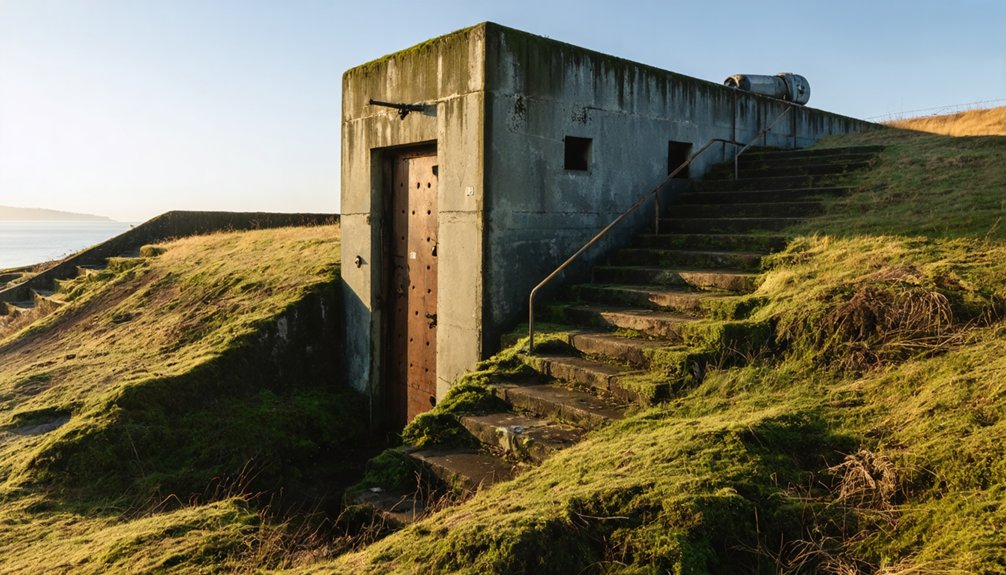You’ll discover America’s most fascinating abandoned military ghost towns at Roosevelt Roads Naval Station in Puerto Rico, Babbitt in Nevada, Fortuna Air Force Station in North Dakota, Saint Marie in Montana, and Finland Radar Base in Minnesota. Each site offers a unique glimpse into Cold War history through decaying infrastructure, vacant housing, and abandoned personal belongings. These eerie time capsules reveal how military communities vanished almost overnight when their missions ended.
Key Takeaways
- Saint Marie, Montana once housed 7,000 residents during its Cold War peak but now stands largely abandoned with just 200-300 residents remaining.
- Roosevelt Roads Naval Station in Puerto Rico features 8,600 acres of abandoned infrastructure after its 2004 closure, with reactivation planned for 2025.
- Babbitt, Nevada was completely abandoned by 1987, with its buildings dismantled following the decline of the Hawthorne Naval Ammunition Depot.
- Fortuna Air Force Station in North Dakota was deactivated in 1984, leaving only its five-story radar tower which now serves as a cell tower.
- Finland Radar Base in Minnesota closed in 1980 after nearly three decades of Cold War operations, with personal belongings left behind during abandonment.
Although now a decaying relic of American military presence in the Caribbean, Roosevelt Roads Naval Station began with Franklin D. Roosevelt himself, who surveyed the site in 1919 as Assistant Secretary of the Navy.
Construction commenced in 1940 after Roosevelt, now president, ordered its development with $50 million in funding.
The ambitious naval station took shape in 1940, fueled by Roosevelt’s presidential directive and substantial federal investment.
This massive 8,600-acre facility featured an 11,000-foot runway, deep-water port, and extensive infrastructure before its 2004 closure following the Vieques range shutdown.
Today, you’ll find abandoned infrastructure throughout—thousands of vacant housing units, stripped buildings, and even unexploded munitions scattered across the landscape.
The base has transformed into a post-apocalyptic military ghost town, attracting urban exploration enthusiasts who wander through its decaying facilities—a stark reminder of the abrupt end to over six decades of naval operations.
The site was officially commissioned as a U.S. Naval Operations Base in 1943 before being re-designated as a Naval Station in 1957.
Recent developments indicate the facility is scheduled for official reactivation on November 14, 2025, potentially ending its ghost town status.
The Forgotten Military Housing of Babbitt, Nevada
While Puerto Rico’s Roosevelt Roads Naval Station decays in tropical humidity, a different military ghost town once stood in Nevada’s arid landscape. Established in 1941, Babbitt housed workers for the Hawthorne Naval Ammunition Depot during WWII.
At its peak, this meticulously planned community featured 584 duplexes, 51 single-family homes, and complete amenities including schools and recreation facilities. Babbitt’s history reflects America’s social evolution—initially segregated, the community gradually integrated during the 1960s through residents’ persistence, demonstrating remarkable community resilience. Like soldiers training at Tonopah Army Air Field during the same era, residents served the war effort in their own way.
Post-Korean War, Babbitt began its slow decline. Buildings were systematically dismantled and relocated throughout rural Nevada. The town was slowly dismantled as military operations decreased, leaving an increasingly empty settlement behind. By 1987, the last residents departed, leaving behind only memories and scattered foundations.
Today, you’ll find little remaining except the Whiskey Flats RV park established in 2004 near the former site.
Fortuna Air Force Station: North Dakota’s Cold War Relic
Nestled at the crossroads of North Dakota, Montana, and Canada, Fortuna Air Force Station emerged in 1952 as a critical Cold War defense installation.
The 780th AC&W Squadron operated advanced radar technology, eventually upgrading to the massive AN/FPS-35 search radar with its 200-mile detection range.
At its peak, this BUIC facility employed 150 personnel, boosting Fortuna’s population to 216 residents by 1970. The station featured comprehensive amenities including a gymnasium and bowling alley for personnel recreation.
Similar to Fort Churchill State Historic Park, Fortuna Air Force Station served as a preservation site documenting America’s military history.
When the station was deactivated in 1984, the town’s population plummeted. Today, only 22 people remain.
You’ll find little of the original 118 buildings, though the five-story radar tower still stands, repurposed as a cell tower.
The abandoned site, now owned by Divide County, stands as a silent tribute to America’s Cold War vigilance.
Saint Marie: Montana’s Deserted Military Community
Originally established in the 1950s as a residential community for Glasgow Air Force Base personnel, Saint Marie represents one of Montana’s most dramatic examples of military abandonment.
At its peak during the Cold War, this thriving community housed over 7,000 people, featuring 1,200 homes, schools, churches, and recreational facilities. The base was strategically built to intercept potential Russian attacks during the height of Cold War tensions.
Saint Marie history follows a classic boom-and-bust cycle: the base operated from 1957-1968 and again from 1971-1976 before closing almost overnight.
Today, with only 200-300 residents, Saint Marie’s abandoned infrastructure attracts urban explorers seeking to document its decay. The once-vibrant runway has been repurposed as the Glasgow Industrial Airport for testing Boeing aircraft.
While exploring Saint Marie, you’ll find the airfield remains active as a Boeing test facility.
The town’s striking contrast of decaying buildings alongside a few restored homes tells the story of America’s shifting military priorities and the communities left behind when bases close.
Finland Radar Base: Minnesota’s Cold War Time Capsule
Perched atop Lookout Mountain near Finland, Minnesota, the Finland Air Force Station emerged in 1950 as a critical radar installation during the early Cold War tensions.
This mountainous outpost became operational in 1951, with the 756th Aircraft Control and Warning Squadron manning cutting-edge Cold War surveillance equipment.
You’ll find the abandoned remains of what was once a self-contained military community housing 350 personnel and their families.
For nearly three decades, powerful radar systems scanned a 250-mile radius for potential Soviet threats approaching from Canadian airspace.
The base joined the SAGE automated defense network in 1959, enhancing America’s protective shield.
The integration of SAGE technology transformed Finland Station into a digital sentinel along America’s northern electronic frontier.
After closing in 1980 due to technological obsolescence, the site was abandoned, leaving behind a frozen-in-time capsule of radar technology and Cold War anxiety.
The rapid evacuation due to environmental hazards left many personal belongings behind, creating the eerie atmosphere that visitors encounter today.
The site operated several Gap Filler sites in Wisconsin and Minnesota to ensure comprehensive radar coverage of the region.
Frequently Asked Questions
Are There Guided Tours Available at These Abandoned Military Sites?
Yes, you’ll find guided explorations at many sites through historical societies and tourism boards. They’ll showcase the historical significance while steering through safety restrictions. Book in advance for legal, informative access.
What Permits Are Required to Legally Explore These Ghost Towns?
The mountain of paperwork required includes federal land permits, state-specific exploration guidelines, and private property permissions. You’ll need to navigate legal restrictions by obtaining access authorizations before your adventure begins.
How Dangerous Is the Radiation at Former Cold War Bases?
You’ll find radiation at Cold War bases varies widely. Most accessible areas have low levels, but restricted zones can be dangerous. Always follow radiation safety guidelines when exploring these sites.
Can Artifacts Be Legally Collected From Abandoned Military Properties?
No, you can’t legally collect artifacts from abandoned military properties. Federal laws strictly prohibit removal, with serious legal implications including fines and imprisonment. Artifact preservation is required by law regardless of your intentions.
Do Any of These Sites Have Paranormal Investigation Opportunities?
Shadows of the past await your investigation. You’ll find paranormal tours at Fort Leavenworth, Fort Monroe, and West Point, where you’re free to bring investigation equipment under regulated access conditions.
References
- https://www.youtube.com/watch?v=9Xs418q7u9I
- https://www.operationmilitarykids.org/abandoned-military-bases/
- https://www.youtube.com/watch?v=3d4bUMUUWxY
- https://www.youtube.com/watch?v=pcX5nv0XhCA
- https://www.prairiepast.com/blog/explore-3/fortuna-afb-85
- https://abandonedwonders.com/tag/abandoned-military-base/
- https://www.youtube.com/playlist?list=PLenYgd5YLQJ744EWXrjBFt-EtBj8FFdPo
- https://www.youtube.com/watch?v=_GXPCLi66xw
- https://www.youtube.com/watch?v=o-CELPqCStg
- https://www.youtube.com/watch?v=MYe6MXx_3rE



